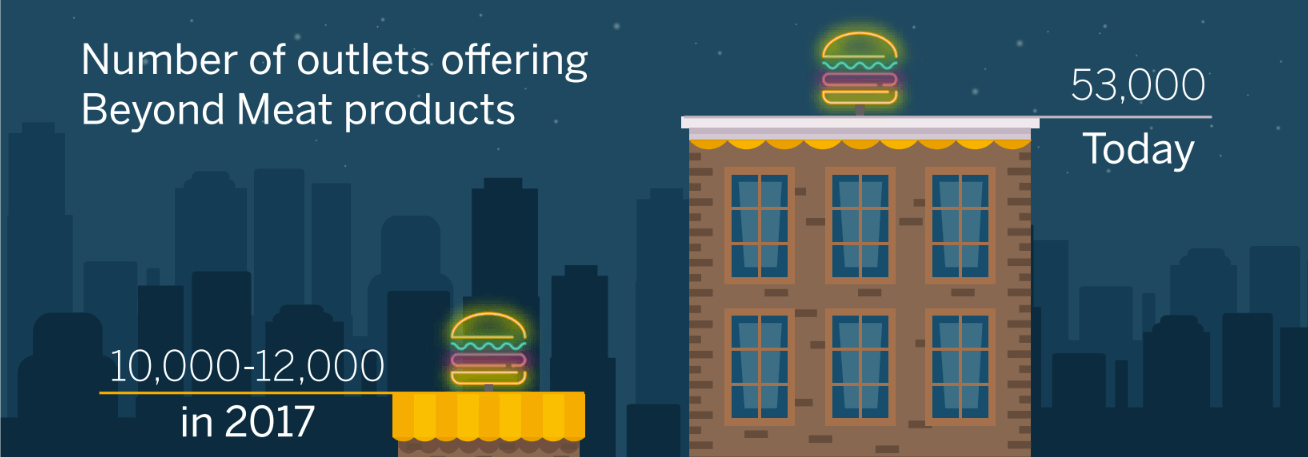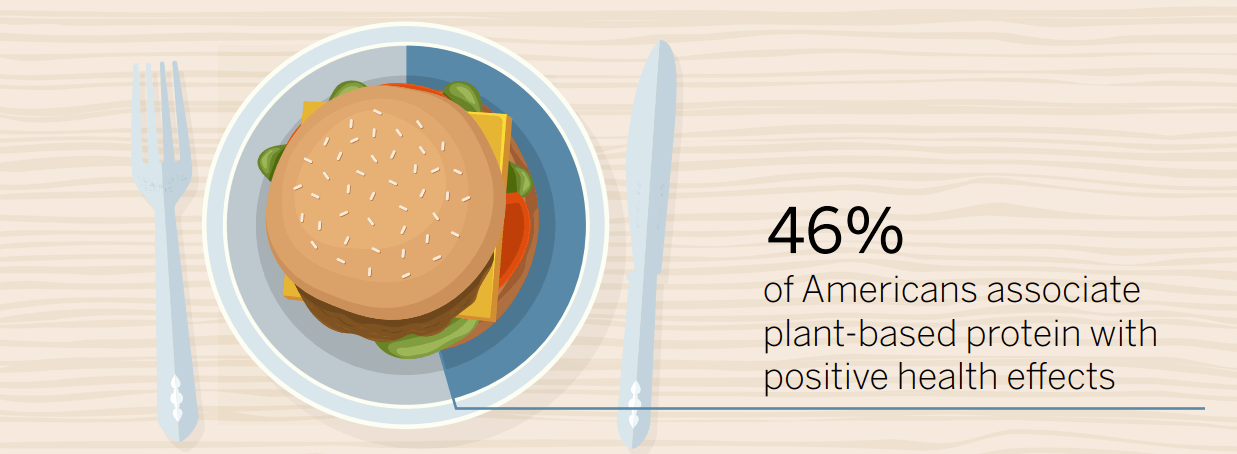One of the biggest names here is Beyond Meat. Founded in 2009 in the US, the company went public in May 2019. Its shares shot up by 163%[mfn]https://www.cnbc.com/2019/09/14/beyond-meat-stock-how-the-alternative-meat-company-surged-500-percent.html[/mfn] on the first day. As at mid-November 2019, its stock was around USD 80[mfn]https://finance.yahoo.com/quote/BYND/history/?guccounter=1&guce_referrer=aHR0cHM6Ly93d3cuZ29vZ2xlLmNvbS8&guce_referrer_sig=AQAAAMZuhwSXFWbijRt3qEzsrwrN_oWdctR9TRJH_eHgD9qNAt6OCAhneJ0o9uu1t3Z8251nWrj4mC3wSV1WmQnOelxFe5Pkydvv5LSJVOn6nIF_nT0HbK5CeJndf9yJnLninWT0AKgf5w3Q4GljktfnHlvAS-iisRxnONhoBcBUxelt[/mfn], up from USD 25[mfn]https://www.cnbc.com/2019/05/01/beyond-meat-prices-ipo-at-25-per-share-source.html[/mfn] initially. It sells fake burgers, sausages, ground beef and crumbles, as well as Beyond Chicken, which was pulled from the shelves to be redeveloped. It can be found globally too – in May 2018, the company announced it would be expanding to more than 50 countries over six continents.
Beyond Meat is part of a huge transformation in food. Rather than creating a totally new market, alternative meats are expected to gain at the expense of meat, an industry worth around USD 950bn globally.[mfn]https://www.globenewswire.com/news-release/2019/05/02/1815144/0/en/Global-Meat-Sector-Market-Analysis-Forecast-Report-2019-A-1-14-Trillion-Industry-Opportunity-by-2023.html[/mfn] And it looks set to expand considerably. According to Allied Market Research, fake meat will be worth USD 8.1bn in 2026, up from USD 4.1bn in 2017.[mfn]https://www.alliedmarketresearch.com/press-release/global-meat-substitute-market.html[/mfn] There are numerous contenders and, according to one expert, the “industry is extremely chaotic at the moment”. As well as newer upstarts, for instance Impossible Foods, there are plenty of established players, such as Quorn and Tofurky. Existing meat manufacturers and supermarkets are also looking to enter this space and create their own brands, for example, Tyson Foods and Kroger.
Beyond Meat’s best known product is its burger. Made of around 20 ingredients, the protein is sourced predominantly from pea isolate, while beetroot extract colours it red. It released a newer version this year, dubbed Beyond Burger 2.0, with an improved recipe that made it “meatier” and “juicier”. One advantage is that Beyond’s products can be manufactured by other companies, which has allowed it to expand quickly into new markets. This has happened rapidly, with the growth in where it’s sold jumping from “roughly 10,000-12,000 outlets in 2017 to over 53,000 today”. Moreover, appearing on restaurant menus helps expand Beyond’s brand presence.

On the foodservice side, it has already partnered with high-profile brands. This year McDonald’s announced that it would be trialling Beyond Burgers at 28 restaurants in Ontario, Canada. Meanwhile, for a trial in Atlanta, KFC became the first American fast-food chain to offer vegan chicken, using Beyond Meat’s “Beyond Fried Chicken”. It sold out in five hours. Other brands it is pairing or trialling with include Dunkin’ Donuts, Carl’s Jr, TGI Fridays and Subway. These partnerships are not only having a positive impact on revenue, but they are also boosting Beyond’s reputation. As one expert puts it : “I think an interesting [tidbit] is that analysts are seeing the tie-up with Subway as a bonus for Subway rather than for Beyond… That’s a pretty great position to be in when you’ve got brands looking to you to revive and grow their business.” If this helps Subway revive its business, it could mean less work for Beyond when trying to convince brands to take on their products.
Impossible Foods is Beyond’s biggest challenger. It’s also been noted that, while Beyond is going for volume, Impossible is focusing on quality and “making the perfect hamburger”. This is reflected in the differences between how the burgers are made. Impossible is 80% soy, which is considered best at replicating the mouthfeel of meat. It also uses heme, an iron-containing molecule found in meat, which adds to its flavour and turns the burger red. The ingredient is extracted from yeast using resin, which is an expensive process. But Impossible is renowned for innovating, with 100 researchers working in their headquarters. Although one specialist thinks it is “primarily a marketing ploy”, this does differentiate the brand and make it unique. This is backed up by its strong social media presence. But what’s really important is the taste – which the heme helps achieve. And there’s a general consensus, including three specialists we recently interviewed, that Impossible’s burger tastes better.
However, the heme and soy protein Impossible uses are GMO. While the company’s website states that these are used responsibly, there is still unease among consumers about GMO and it could be used as a criticism by the meat industry. Impossible is also not as widely available as Beyond. Until recently, it was only found in restaurants in America, as well as Hong Kong, Singapore and Macau.[mfn]https://impossiblefoods.com/mission/2019impact/scalingup/[/mfn] But it recently launched in stores in America, and the company has put in an application to be sold in the EU – as Impossible’s burger contains GMO ingredients, it will need to be approved for sale. Impossible also has a partnership with Burger King in the US, which proved so successful that it is trialling three more plant-based burgers at 180 locations.[mfn]https://thetakeout.com/burger-king-new-impossible-burgers-kids-meal-1839801534[/mfn] Although Impossible has had supply-chain issues, earlier this year it entered into a co-manufacturing agreement with OSI, a global food manufacturer that already supplies McDonald’s.

Another future obstacle for Beyond could be distaste for artificial ingredients. As pointed out already, Beyond Burgers have a lot of ingredients. But consumers will make “random choices” in the name of health, like choosing a sugar-free drink with a fast-food meal. In fact, plant-based protein is associated with positive health effects by 46% of Americans. However, this discounts how many people choose products like Beyond for ethical reasons. It’s not just vegans who choose fake meat, but there is rising interest in “flexitarian” diets and vegetarianism, as well as people who don’t eat meat for cultural or religious reasons.
There is also the issue of cell-based meat, which is developed in a laboratory using animal cells. These cells can be programmed to contain less or healthier fats. Moreover, having less ingredients means they would appear more natural to consumers. One expert thinks this “could play out interestingly in a couple of years’ time when those products are ready to come to market.” Depending on how consumers react to lab-grown meat, this could have implications for Beyond Meat and companies like it.
The information used in compiling this document has been obtained by Third Bridge from experts participating in Forum Interviews. Third Bridge does not warrant the accuracy of the information and has not independently verified it. It should not be regarded as a trade recommendation or form the basis of any investment decision.
For any enquiries, please contact sales@thirdbridge.com


